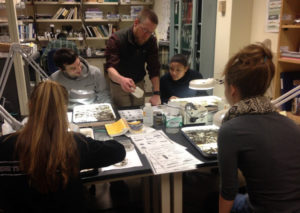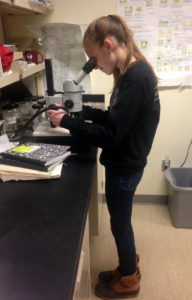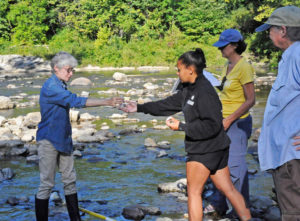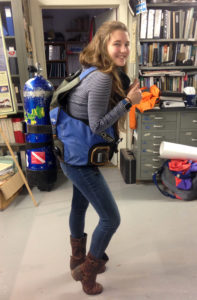Matthew Witten and Elizabeth Lee, LCMM, 2017
In mid-December Aaron Moore greeted us, brought us into the lab, and gave us each a seat in front of a wide, flat pan with dead insect larvae covering the bottom. Not your normal field trip. Everyone was very curious.

Aaron is a field scientist at Vermont Department of Environmental who does biological assessments of rivers. He explained to three of our Watershed Science Apprentices and one AmeriCorps member that benthic macroinvertebrates – organisms that frequent the bottom of water bodies – indicate the water quality and general health of aquatic habitats. We were there as
volunteers to help sort the bugs into different types (or “taxa”), so that the experts could spend less time on sorting them and more time identifying them to genus and sometimes species. The pans in front of us were full of insect larvae from water samples taken in Addison County streams including Lewis Creek and the New Haven River.

Olivia B., one of our apprentices, said later, “That was a cool experience. I never realized people could actually do something like that as a job. I found it surprisingly relaxing. I had the Lewis Creek and there were a lot of bugs! There were a ton of stoneflies and a huge Dobsonfly larvae. This is definitely something you should do with future groups. Personally I would 10/10 do it again, and I bet others would be just as interested.”
This was just one of the many real-world experiences that our Watershed Science Apprentices are having. The Watershed Science Apprenticeship for Young Women (WSA), funded largely by the Vermont Women’s Fund, is one program in LCMM’s array of Skill-Builds that engage students from area schools in water- and maritime-related activities. These activities are designed to stimulate and fulfill students’ interests in personalized learning, independent study, and marketable skills.

The WSA is open to girls in grades 7-12 at Mt Abe, Middlebury, Vergennes, and Champlain Valley middle/high schools. It is a water quality assessment training course that spends a lot of time with professionals in the water quality field, and helps participating girls to take on aquatic field studies of their own choosing, and ideally get school credit for their projects.
Apprentices come for different reasons. They can supplement their science or math credits, participate in service work or gain experience in professional-level scientific endeavors involving wetlands, streams, and lakes.

In January the Watershed Science Apprentices met with the nautical archaeologists at LCMM. Allyson Ropp and Jenny Craig explained their career paths to becoming professional archaeologists. WSA girls got to try on SCUBA equipment! Allyson earned an MA from East Carolina University in Nautical Archaeology in December, after presenting her research on pirate shipwrecks. Jenny is earning a PhD from McGill University and has studied shipwrecks around the world. Her doctorate focuses on the analysis of beads found on shipwrecks as a means of tracking the history of commerce in Southeast Asia.
Coming in March and April, the Watershed Apprentices will visit Jenna Calvi, the Stormwater Program Manager for the City of Burlington, Paula Jackson, Water Operator for the City of Burlington’s Water Treatment Plant, and Lindsay Dreiss, Middlebury College professor of geographic information systems (GIS).
Enrollment in the WSA is ongoing.
For more information, contact Elizabeth Lee, elizabethl@lcmm.org
Photo Credits: Elizabeth Lee and Matthew Witten
